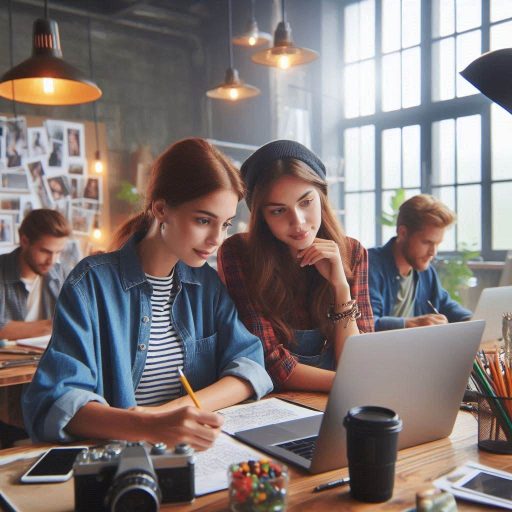Introduction
The Importance of Set Design in Various Industries
Set design plays a crucial role in shaping the visual experience across various industries.
In film, theater, and live performances, it helps create immersive environments that draw audiences into the story.
In events and retail spaces, set design enhances brand presence and customer engagement.
Effective set design communicates themes, influences moods, and transforms ordinary spaces into dynamic environments that captivate attention.
Rapid Advancements in Technology Influencing Set Design Trends
Technology is rapidly reshaping how set designers create these captivating environments.
The integration of digital elements like LED screens and augmented reality (AR) is transforming traditional approaches.
Virtual production tools are now common, enabling designers to craft dynamic, real-time backgrounds without physical builds.
These innovations streamline the process, reduce costs, and enhance creative possibilities.
Trends to Watch in 2024
As we look ahead to 2024, several set design trends are emerging, driven by these technological advancements.
Expect to see increased use of immersive environments that combine physical and digital elements.
Sustainable design practices are also gaining momentum, as more designers prioritize eco-friendly materials and energy-efficient solutions.
Virtual and Augmented Reality Integration
VR and AR Technologies Revolutionizing Set Design
Virtual Reality (VR) and Augmented Reality (AR) are changing how set design teams bring stories to life.
Designers now integrate these technologies to create dynamic and interactive environments.
VR allows designers to visualize and manipulate spaces in real time before physical construction begins.
This level of control reduces costs, minimizes errors, and accelerates the production process.
With AR, set designers can layer digital elements onto physical spaces, enhancing audience engagement.
These tools enable more imaginative and flexible set designs that can be altered with ease during production.
Traditional set designs often had limitations in terms of space and resources.
However, VR and AR break those barriers.
With VR, designers and directors can enter fully virtual worlds, assessing every detail before a single prop is built.
AR can add depth to these designs by blending digital elements with the real world, opening up new creative possibilities.
This combination of technologies offers set designers more freedom to experiment with visual storytelling.
These innovations are already reshaping how we experience theater, film, and live events.
Creating Immersive Experiences for Audiences
Set design is no longer just about creating visually appealing backdrops.
In 2024, VR and AR are allowing creators to offer immersive experiences.
Audiences are no longer passive observers; they can become part of the action.
Designers use VR to build virtual environments where audiences can interact with characters, objects, and the world around them.
AR enhances these experiences by integrating virtual elements into real-world settings, making the audience feel like they are inside the story.
This shift is not only transforming how set designers approach their craft, but it‘s also enhancing audience engagement.
In immersive theater, for example, AR can bring objects to life in front of the audience’s eyes.
VR sets can transport viewers to entirely new worlds, adding a layer of depth and interactivity that wasn‘t possible before.
This technology blurs the line between set design and storytelling, making the audience feel like they are a part of the story.
As more designers explore these tools, the boundary between the stage and the audience will continue to dissolve.
Successful VR and AR-Integrated Set Designs
Several productions in recent years have successfully integrated VR and AR into their set designs.
One notable example is the VR production of The Tempest by the Royal Shakespeare Company.
The designers used VR to create a magical, stormy environment that enhanced the narrative.
Another example is AR‘s use in Harry Potter and the Cursed Child, where magical elements such as spells and creatures appeared through digital projections, blending seamlessly with the physical set.
These examples showcase how VR and AR are pushing set design into new creative territories.
By integrating digital and physical elements, these technologies offer limitless possibilities for storytelling.
As more productions embrace these tools, audiences can expect to see even more innovative and immersive designs in the future.
Set design in 2024 and beyond will continue to evolve, driven by the boundless potential of VR and AR technologies.
Read: Freelance Character Design: How to Get Started
Sustainable and Eco-friendly Design
The Growing Importance of Sustainability in Set Design
Sustainability in set design has become a top priority as environmental concerns intensify.
Designers are responding to the growing demand for eco-friendly practices by incorporating sustainable techniques into every aspect of production.
In 2024, sustainability is no longer a niche concept but a necessity.
Production companies, designers, and audiences are increasingly aware of the impact their work has on the environment.
Designers are now expected to create sets that are visually stunning while minimizing their environmental footprint.
Eco-conscious decisions are shaping how sets are planned, built, and dismantled.
By focusing on long-term environmental benefits, designers are prioritizing materials and processes that reduce waste and energy consumption.
This shift towards sustainability is not just a passing trend; it‘s becoming standard practice in the entertainment industry.
Recycled Materials and Eco-Friendly Techniques
One of the most effective ways to embrace sustainability in set design is through the use of recycled materials.
More designers are turning to reclaimed wood, recycled plastics, and salvaged metals to build sets.
These materials, often sourced from previous productions or discarded items, allow designers to reduce waste while maintaining a high-quality aesthetic.
In 2024, the use of eco-friendly paints, biodegradable textiles, and non-toxic adhesives is on the rise.
These materials minimize harmful emissions and reduce the environmental impact of set construction.
Water-based paints and organic fabrics are replacing their synthetic and chemical-laden counterparts.
Eco-friendly techniques such as modular design also allow sets to be reused or reconfigured for different scenes or productions.
This minimizes the need for new materials and reduces the overall waste produced by the set-building process.
Sustainability doesn‘t end with construction.
Designers are implementing energy-efficient lighting and powering sets with renewable energy sources.
By integrating solar panels and LED lights, they significantly reduce energy consumption during production.
Environmentally Conscious Set Designs in 2024
Set design in 2024 is not only about aesthetics but also about environmental responsibility.
Designers are creating sets that reflect a commitment to sustainability while still delivering a captivating visual experience.
This trend towards environmentally conscious set design is reshaping how designers approach their craft.
In 2024, we see a push towards multifunctional and adaptable set designs that can be repurposed for various productions.
By creating sets with flexibility in mind, designers are reducing the need for new materials with each production, thus minimizing waste.
These sets are often designed with modular elements that can be rearranged or updated to fit different themes and styles.
Moreover, the integration of virtual set design is gaining momentum, offering an alternative to physical construction.
Virtual sets allow for limitless creativity without the environmental impact of traditional builds.
This digital approach reduces the need for raw materials, transportation, and storage, making it an eco-friendly alternative.
In a nutshell, sustainability is no longer an afterthought in set design.
It is driving innovation, challenging designers to rethink traditional practices, and encouraging them to adopt eco-friendly techniques that are reshaping the industry in 2024.
Read: Career Paths: Becoming a Professional Character Designer
Interactive and Dynamic Sets
The Rise of Interactive Sets in 2024
Interactive sets are transforming the way audiences engage with productions.
In 2024, set design is evolving to embrace audience participation.
Set designers are creating immersive environments that respond directly to viewers’ actions, blurring the lines between audience and performer.
These interactive spaces enhance the storytelling experience by involving spectators in a more hands-on way.
Whether it’s film, theater, or live events, designers are increasingly exploring how technology can facilitate this interaction.
The result is an engaging, memorable experience that leaves a lasting impression on audiences.
A key trend driving this shift is the use of sensors and motion tracking systems.
These technologies enable set elements to react in real-time to audience movements.
For example, lights may change colors as someone enters a particular area, or sound effects may adjust based on crowd noise.
This level of interaction heightens emotional involvement, making spectators feel like active participants rather than passive viewers.
As technology advances, the possibilities for creating these kinds of dynamic experiences continue to expand.
The Role of Technology in Dynamic Set Design
Technology plays a crucial role in creating dynamic and adaptable sets.
Innovations in projection mapping, AR, and AI allow designers to craft flexible environments that can change instantly.
Projection mapping enables set pieces to shift scenes without physically moving structures, creating visual transformations that occur right before the audience’s eyes.
This technique has been widely used in theater and concerts to create dynamic backdrops and atmospheres.
In 2024, the use of AR is expected to further enhance this adaptability by overlaying digital elements onto physical sets, adding new layers of engagement.
AI also plays a role in creating adaptable set designs.
AI-driven algorithms can modify aspects of the set based on audience feedback or pre-programmed cues.
For instance, lighting and sound systems can adjust automatically to reflect the mood of the scene, creating a seamless flow of transitions.
These dynamic elements allow productions to be more fluid and responsive, offering a tailored experience for each performance or event.
With the advancement of these technologies, set designers have greater flexibility to experiment with creative possibilities.
Examples of Interactive and Dynamic Sets
Film, theater, and live events have been at the forefront of using interactive and dynamic set designs.
In cinema, films like Blade Runner 2049 featured highly adaptable sets that utilized AR and projection mapping to create futuristic, ever-changing cityscapes.
Theater productions, like Sleep No More, offer an immersive, interactive experience where the audience moves through multiple rooms, each filled with evolving set pieces.
Every room reacts to the presence of the audience, creating a fluid, nonlinear experience.
In live events, interactive stages have become more popular.
For example, Coldplay’s Music of the Spheres tour used LED wristbands and projection technology to involve the audience directly.
As fans moved, the lights and visuals adapted, creating a fully immersive concert experience.
These examples highlight how dynamic and interactive sets are redefining the future of storytelling, creating productions that are more engaging, responsive, and personalized.
Read: Best Tools and Software for Character Designers
Minimalist and Futuristic Aesthetics
The Shift Towards Minimalist and Futuristic Set Designs
In 2024, set design is embracing minimalism with futuristic touches, redefining aesthetics in television, film, and theater.
Designers are moving away from cluttered, overly detailed backdrops in favor of sleek, streamlined environments.
Minimalist set design emphasizes simplicity, clarity, and purpose, ensuring every element serves a functional and visual role.
By reducing distractions, these designs allow the audience to focus on the story, creating a powerful visual impact.
The shift towards minimalism signals a growing preference for clean, open spaces that reflect contemporary sensibilities, marking a major trend for the coming year.
Sleek Lines, Geometric Shapes, and Metallic Accents
Futuristic set designs in 2024 often feature sleek lines, geometric shapes, and metallic accents, adding to their modern appeal.
These elements create a sense of precision and order, essential to the futuristic aesthetic.
Sleek lines emphasize simplicity, while geometric shapes add structure and depth to the space.
These features evoke an almost architectural feel, grounding the set in a futuristic reality.
Metallic accents, whether in furniture, lighting fixtures, or props, introduce a high-tech, industrial vibe that reinforces the forward-thinking nature of the design.
Together, these design elements create a visually striking, minimalist set that feels both modern and forward-looking.
Reflecting a Modern and Minimalist Aesthetic
The modern aesthetic in 2024 set design focuses on creating environments that are not only functional but visually captivating.
A minimalist approach aligns with broader trends in interior design and architecture, where less is more.
This trend reflects a shift towards sustainability, with set designers using fewer materials and repurposing existing ones.
By focusing on essentials, designers can reduce waste and create more eco-friendly sets.
The use of neutral color palettes, such as whites, grays, and blacks, paired with metallic finishes, gives the set a polished and refined look.
The absence of unnecessary clutter allows the audience to fully immerse themselves in the narrative without distraction.
Creating Immersive, Futuristic Worlds
Minimalist and futuristic set designs are not just about aesthetics‘they also enhance the storytelling experience.
By creating streamlined, futuristic environments, designers immerse audiences in worlds that feel authentic and believable.
These designs often feature high-tech elements, such as integrated lighting, smart technology, and innovative materials, to convey a sense of advancement.
This trend is particularly relevant in science fiction and dystopian narratives, where futuristic settings play a crucial role in storytelling.
Minimalist set designs also allow for more versatility in lighting and camera work, enhancing the overall production value.
The future of set design lies in creating spaces that are both visually compelling and adaptable to the evolving demands of modern productions.
In 2024, the shift towards minimalist and futuristic set design marks a significant evolution in the industry.
Read: Ceramic Art: From Hobby to Professional Career
Transform Your Career Today
Unlock a personalized career strategy that drives real results. Get tailored advice and a roadmap designed just for you.
Start Now
Cultural and Diversity Representation
Addressing the Importance of Cultural and Diversity Representation in Set Design
Cultural representation in set design has become essential in today’s diverse entertainment landscape.
As media becomes more globalized, audiences expect authentic reflections of different cultures and perspectives.
Set design plays a crucial role in shaping the narrative by visually telling stories that resonate with various communities.
Ignoring cultural diversity in design can alienate audiences and perpetuate stereotypes.
Designers must incorporate inclusive elements to create environments that reflect our world accurately.
When sets represent a wide range of cultures and backgrounds, they contribute to more meaningful and engaging storytelling.
Authentic set design fosters a deeper emotional connection with the audience, ensuring that everyone feels seen and represented.
Set designers are also increasingly working with cultural consultants and experts.
This collaboration helps ensure that the environments they create are respectful and culturally accurate.
By representing various cultures authentically, designers avoid perpetuating harmful clich‘s and misrepresentations.
This shift towards inclusivity in set design isn’t just a trend; it‘s a necessary evolution that ensures representation and respect for all viewers.
As more shows and films focus on diverse storytelling, the demand for culturally aware set design will only increase.
Exploring the Trend of Incorporating Diverse Influences and Perspectives in Sets
Modern set design is embracing the trend of incorporating diverse influences and perspectives.
Designers are increasingly pulling from global cultures, traditions, and aesthetics to create environments that feel authentic and vibrant.
This trend goes beyond simply adding cultural tokens to sets.
It involves thoughtful integration of design elements that reflect a genuine understanding of different backgrounds.
Set designers are now actively researching and collaborating with diverse teams.
They bring unique voices into the design process, allowing for the exploration of various cultural narratives.
This approach enriches the visual experience and adds layers of meaning to the set, making it more relatable to global audiences.
The integration of diverse perspectives has also led to more creative and visually striking sets, as designers experiment with non-traditional color schemes, textures, and materials.
These sets are not only beautiful but also resonate with viewers on a deeper level by reflecting the richness of human experience.
The rise of streaming platforms has also played a role in this trend.
Shows and films now reach international audiences, making it vital for set designers to incorporate global perspectives.
Audiences are more aware of cultural nuances and appreciate when these are reflected in set design.
This global influence has led to a new wave of storytelling, where diverse cultural elements are not only accepted but celebrated.
Examples of Sets That Successfully Incorporate Cultural Elements and Diversity
Several productions have successfully incorporated cultural elements and diversity into their set designs.
One standout example is the Marvel movie Black Panther, which embraced African culture through its futuristic yet deeply rooted African-inspired set design.
From the vibrant colors to the architectural influences, the set design paid homage to African traditions while creating a futuristic, imaginative world.
Similarly, the set design for Crazy Rich Asians celebrated Southeast Asian culture.
By integrating elements from Chinese and Singaporean architecture, the sets provided an immersive and authentic experience for viewers.
The attention to cultural detail added depth to the story, making the world feel lived-in and real.
In television, shows like Narcos have also integrated cultural elements into their set designs.
By accurately depicting the environments of Colombia, the show transported audiences into a specific time and place.
These sets not only looked visually stunning but also enhanced the storytelling by providing a rich, authentic backdrop for the narrative.
Through these examples, it‘s clear that diverse set design has a lasting impact on viewers.
By embracing cultural influences, designers can create sets that resonate across cultural boundaries, enriching the visual experience and elevating the story.
Integration of Smart Technology
The Impact of Smart Technology on Set Design
Smart technology is revolutionizing set design in ways that were unimaginable just a few years ago.
With advancements in automation, artificial intelligence (AI), and the Internet of Things (IoT), set designers are embracing these innovations to enhance the visual storytelling experience.
Smart tech creates dynamic, responsive environments that adapt to the needs of a scene in real-time.
This shift allows designers to reduce manual labor and improve efficiency, leading to more immersive and engaging performances.
Incorporating smart technology into set design is not just a trend but a new standard for the future.
The Use of Automation, IoT, and AI in Creating Intelligent Sets
Automation has become a game changer in set design, streamlining previously complex tasks.
Moving platforms, lighting adjustments, and scenery shifts can now be controlled remotely or pre-programmed to match specific moments in a scene.
This allows designers to focus on the creative aspects, knowing that the technical details are handled by the technology.
Additionally, IoT devices enable different elements on a set to communicate with each other, creating interconnected systems.
For instance, lighting can automatically adjust based on an actor’s position, and cameras can follow movements without human intervention.
AI plays a role in analyzing data from these systems, learning patterns, and suggesting improvements.
It can also help in generating real-time visual effects, making it easier to integrate technology-driven set pieces that react dynamically to the performance.
Trends Towards Incorporating Smart Technology in Set Design in 2024
Set design in 2024 will increasingly lean towards integrating smart technology to meet the demands of modern productions.
More designers are adopting interactive technologies to create adaptive environments, especially in live performances and television.
Projection mapping, for instance, will continue to grow in popularity, enabling designers to transform static backgrounds into evolving visual experiences.
Voice-activated systems will also play a role, allowing directors and crew members to make real-time adjustments through simple voice commands.
Additionally, sustainable design practices will blend with smart technology, with eco-friendly, energy-efficient systems controlling lighting and scenery changes.
Many set designs will incorporate modular elements that can be quickly rearranged and programmed for different uses, making production more flexible.
In 2024, the rise of AI-driven design tools will allow for more experimentation in creating intelligent, responsive sets.
These trends reflect the growing need for sets that are not only visually appealing but also efficient and sustainable.
Designers will use smart technology not just as a tool but as a fundamental part of the creative process.
The future of set design lies in its ability to blend artistry with cutting-edge innovations, offering endless possibilities for creating unforgettable experiences.
You Might Also Like: Top Game Design Conferences to Attend
Multi-functional and Versatile Sets
Trend Towards Multi-Purpose Set Design
In 2024, set design is evolving to meet the demand for more versatile, multi-purpose spaces.
Set designers are increasingly prioritizing flexibility, ensuring that one set can serve multiple functions.
This trend allows production teams to create dynamic environments without the need for entirely new sets for each scene or event.
As industries embrace sustainability, the push toward multi-functional sets helps reduce waste, cut costs, and optimize resources.
This approach benefits a wide range of sectors, from film and television production to theater and live events, offering greater adaptability and creative possibilities.
Multi-purpose set design is a direct response to the growing need for efficiency and resourcefulness.
By reimagining spaces and incorporating adaptable elements, designers can transform a single location into various environments.
This shift not only maximizes the use of materials but also enhances storytelling by creating seamless transitions between scenes.
A multi-functional set reduces the number of build-outs and strikes, saving valuable time and labor.
Productions can focus more on the creative aspects rather than logistical constraints, leading to more innovative and immersive experiences for audiences.
Modular Elements and Flexible Layouts
Modular elements are central to this trend, allowing for easy reconfiguration of set designs.
These interchangeable pieces offer designers the flexibility to rearrange, resize, and repurpose sets based on the specific needs of a production.
Modular design also enhances mobility, making it easier to transport and set up components in different locations.
This approach is particularly valuable for touring productions or events that require quick turnarounds between scenes.
Flexible layouts further amplify the potential for multi-purpose set design.
Sets with adjustable walls, movable furniture, and customizable backdrops can shift from one setting to another with minimal effort.
These adaptable layouts allow designers to create environments that feel both expansive and intimate, depending on the needs of the scene or event.
This versatility enables productions to explore a wider range of visual possibilities without being confined to static, unchangeable designs.
Incorporating technology into modular and flexible layouts adds another layer of innovation.
Interactive LED screens, movable lighting rigs, and smart automation systems allow sets to change in real-time, creating dynamic environments that respond to the action unfolding within them.
These technological advancements bring a futuristic edge to set design, enhancing the overall experience for both creators and audiences.
Examples of Versatile Set Design
One notable example of multi-purpose set design is the stage for television shows like Saturday Night Live.
Their use of modular backdrops and interchangeable set pieces allows the production to quickly switch between vastly different scenes.
With limited time between live segments, the ability to adapt and modify sets is essential for maintaining the flow of the show.
Another example is in theater, where productions like Hamilton have employed a rotating stage and movable set pieces.
This design not only enhances the storytelling but also provides a fluid and engaging visual experience for the audience.
Versatile set designs are transforming the future of production, allowing for greater creativity, sustainability, and efficiency.
Learn More: Effective Time Management for Advertising Designers
Conclusion
Set design in 2024 is evolving, with key trends shaping the future of the industry.
Sustainability will be at the forefront, as designers increasingly focus on eco-friendly materials and energy-efficient practices.
Modular and adaptable sets will gain traction, offering flexibility for various productions and locations.
Technology will play a major role, with virtual reality (VR) and augmented reality (AR) enhancing storytelling possibilities.
Immersive experiences will also take center stage, blurring the line between the audience and the performance space.
Staying updated on these advancements is crucial for set designers aiming to remain competitive.
Embracing new technologies and sustainable practices can help designers create innovative and impactful work.
Designers must also be aware of industry shifts and emerging trends to meet client expectations and push creative boundaries.
Exploring these trends in your own set designs can open doors to fresh ideas and exciting opportunities.
Experimenting with new technologies or sustainable materials can transform how you approach projects.
By staying current and incorporating the latest innovations, you can ensure your designs stand out in the fast-evolving world of set design.
Keep an open mind, and don’t be afraid to push your creative limits.
[E-Books for Sale]
The Big Book of 500 High-Paying Jobs in America: Unlock Your Earning Potential
$19.99 • 500 High-Paying Jobs • 330 pages
Explore 500 high-paying jobs in America and learn how to boost your career, earn more, and achieve success!
See All 500 High-Paying Jobs of this E-Book
1001 Professions Without a Degree: High-Paying American Jobs You Can Start Now
$19.99 • 1001 Professions Without a Degree • 174 pages
Discover 1001 high-paying jobs without a degree! Unlock career tips, skills, and success strategies for just $19.99!




